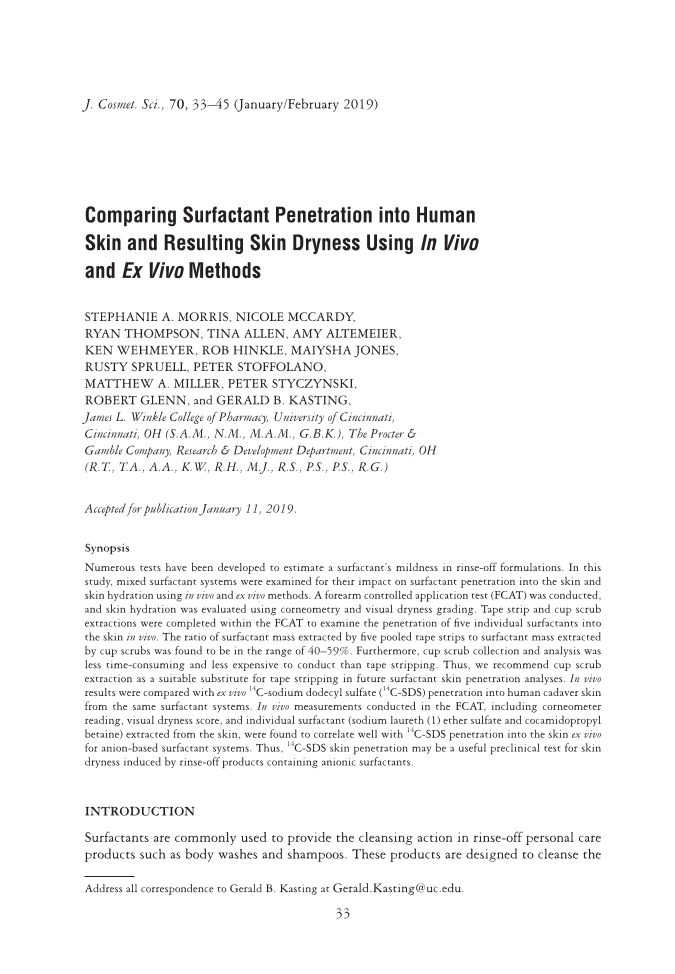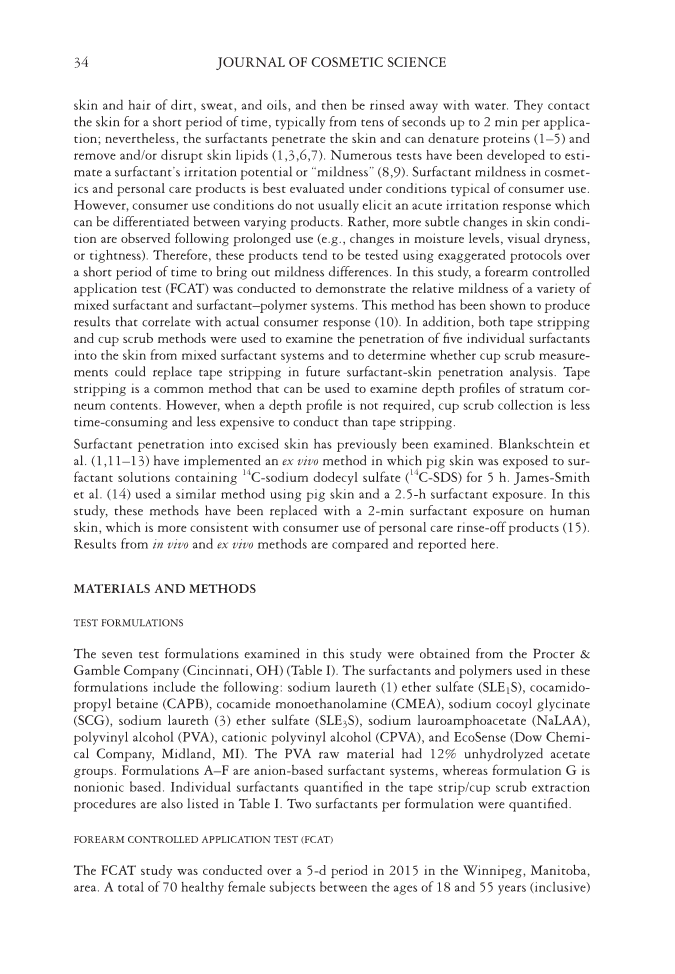J. Cosmet. Sci., 70, 33–45 (January/February 2019) 33 Comparing Surfactant Penetration into Human Skin and Resulting Skin Dryness Using In Vivo and Ex Vivo Methods STEPHANIE A. MORRIS, NICOLE MCCARDY, RYAN THOMPSON, TINA ALLEN, AMY ALTEMEIER, KEN WEHMEYER, ROB HINKLE, MAIYSHA JONES, RUSTY SPRUELL, PETER STOFFOLANO, MATTHEW A. MILLER, PETER STYCZYNSKI, ROBERT GLENN, and GERALD B. KASTING, James L. Winkle College of Pharmacy, University of Cincinnati, Cincinnati, OH (S.A.M., N.M., M.A.M., G.B.K.), The Procter & Gamble Company, Research & Development Department, Cincinnati, OH (R.T., T.A., A.A., K.W., R.H., M.J., R.S., P.S., P.S., R.G.) Accepted for publication January 11, 2019. Synopsis Numerous tests have been developed to estimate a surfactant’s mildness in rinse-off formulations. In this study, mixed surfactant systems were examined for their impact on surfactant penetration into the skin and skin hydration using in vivo and ex vivo methods. A forearm controlled application test (FCAT) was conducted, and skin hydration was evaluated using corneometry and visual dryness grading. Tape strip and cup scrub extractions were completed within the FCAT to examine the penetration of fi ve individual surfactants into the skin in vivo. The ratio of surfactant mass extracted by fi ve pooled tape strips to surfactant mass extracted by cup scrubs was found to be in the range of 40–59%. Furthermore, cup scrub collection and analysis was less time-consuming and less expensive to conduct than tape stripping. Thus, we recommend cup scrub extraction as a suitable substitute for tape stripping in future surfactant skin penetration analyses. In vivo results were compared with ex vivo 14 C-sodium dodecyl sulfate (14C-SDS) penetration into human cadaver skin from the same surfactant systems. In vivo measurements conducted in the FCAT, including corneometer reading, visual dryness score, and individual surfactant (sodium laureth (1) ether sulfate and cocamidopropyl betaine) extracted from the skin, were found to correlate well with 14 C-SDS penetration into the skin ex vivo for anion-based surfactant systems. Thus, 14 C-SDS skin penetration may be a useful preclinical test for skin dryness induced by rinse-off products containing anionic surfactants. INTRODUCTION Surfactants are commonly used to provide the cleansing action in rinse-off personal care products such as body washes and shampoos. These products are designed to cleanse the Address all correspondence to Gerald B. Kasting at Gerald.Kasting@uc.edu.
JOURNAL OF COSMETIC SCIENCE 34 skin and hair of dirt, sweat, and oils, and then be rinsed away with water. They contact the skin for a short period of time, typically from tens of seconds up to 2 min per applica- tion nevertheless, the surfactants penetrate the skin and can denature proteins (1–5) and remove and/or disrupt skin lipids (1,3,6,7). Numerous tests have been developed to esti- mate a surfactant’s irritation potential or “mildness” (8,9). Surfactant mildness in cosmet- ics and personal care products is best evaluated under conditions typical of consumer use. However, consumer use conditions do not usually elicit an acute irritation response which can be differentiated between varying products. Rather, more subtle changes in skin condi- tion are observed following prolonged use (e.g., changes in moisture levels, visual dryness, or tightness). Therefore, these products tend to be tested using exaggerated protocols over a short period of time to bring out mildness differences. In this study, a forearm controlled application test (FCAT) was conducted to demonstrate the relative mildness of a variety of mixed surfactant and surfactant–polymer systems. This method has been shown to produce results that correlate with actual consumer response (10). In addition, both tape stripping and cup scrub methods were used to examine the penetration of fi ve individual surfactants into the skin from mixed surfactant systems and to determine whether cup scrub measure- ments could replace tape stripping in future surfactant-skin penetration analysis. Tape stripping is a common method that can be used to examine depth profi les of stratum cor- neum contents. However, when a depth profi le is not required, cup scrub collection is less time-consuming and less expensive to conduct than tape stripping. Surfactant penetration into excised skin has previously been examined. Blankschtein et al. (1,11–13) have implemented an ex vivo method in which pig skin was exposed to sur- factant solutions containing 14 C-sodium dodecyl sulfate (14C-SDS) for 5 h. James-Smith et al. (14) used a similar method using pig skin and a 2.5-h surfactant exposure. In this study, these methods have been replaced with a 2-min surfactant exposure on human skin, which is more consistent with consumer use of personal care rinse-off products (15). Results from in vivo and ex vivo methods are compared and reported here. MATERIALS AND METHODS TEST FORMULATIONS The seven test formulations examined in this study were obtained from the Procter & Gamble Company (Cincinnati, OH) (Table I). The surfactants and polymers used in these formulations include the following: sodium laureth (1) ether sulfate (SLE1S), cocamido- propyl betaine (CAPB), cocamide monoethanolamine (CMEA), sodium cocoyl glycinate (SCG), sodium laureth (3) ether sulfate (SLE3S), sodium lauroamphoacetate (NaLAA), polyvinyl alcohol (PVA), cationic polyvinyl alcohol (CPVA), and EcoSense (Dow Chemi- cal Company, Midland, MI). The PVA raw material had 12% unhydrolyzed acetate groups. Formulations A–F are anion-based surfactant systems, whereas formulation G is nonionic based. Individual surfactants quantifi ed in the tape strip/cup scrub extraction procedures are also listed in Table I. Two surfactants per formulation were quantifi ed. FOREARM CONTROLLED APPLICATION TEST (FCAT) The FCAT study was conducted over a 5-d period in 2015 in the Winnipeg, Manitoba, area. A total of 70 healthy female subjects between the ages of 18 and 55 years (inclusive)
Purchased for the exclusive use of nofirst nolast (unknown) From: SCC Media Library & Resource Center (library.scconline.org)


























































